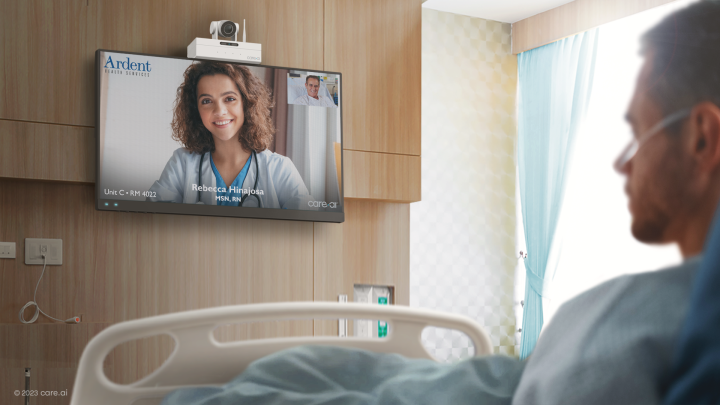
Hospitals explore virtual nursing to cover staffing shortages and fight burnout
Hospitals explore virtual nursing to cover staffing shortages and fight burnout

There was a week at the peak of the pandemic when John Donga of Albuquerque says he held the hands of more dying people than he had in more than a decade of being a nurse. And even though the job had become so stressful, he never considered leaving until he fell at home over the summer and seriously injured his knee.
He still tried to walk the halls and lift patients through the pain.
“I literally got home that day, and I laid down on the couch and I was icing my knee. And I was at the point of tears,” he recalled, “telling my wife, ‘I don’t know what I’m going to do.’”
At 50, Donga is the sole breadwinner. Plus, he still loved working in an emergency department. “I wasn’t ready to quit nursing,” he said. “I was not ready to stop helping people.”
Virtual work has changed industries in a way that could not have been envisioned before the pandemic. But some careers like bedside nursing couldn’t go remote — and for good reason. With nurses facing burnout like never before and threatening to quit in startling numbers, some hospitals are exploring what kind of work-from-home options could keep experienced RNs on the job longer.
For Donga, Lovelace Medical Center was starting a pilot project and thought he could help pioneer virtual nursing in the hospital.
For the last few months, Donga has been beaming in on the hospital’s 40-bed emergency department. Lovelace installed sophisticated cameras, and patients see Donga’s friendly face on flatscreen monitors.
Donga said he can see the massive potential, beyond being able to work while injured. He had never considered being able to telecommute from home when the snow hits. That could soon be reality, though for now, he completes his virtual rounds from within the hospital. And Donga checks in on 15 patients an hour, he said.
“Half the time I’m seeing those patients, they’re asleep or they’re not in the room. But I’m easily able to do it,” he said, noting how much time is saved from walking the halls and being distracted by other requests. “I can see how I could do 20 or 30 depending on what they need. So one virtual nurse can really help a lot.”
His remote visits are supposed to free up in-person nurses so they can spend time with those who require face-to-face attention. But Donga said his one concern is that this form of automation isn’t used to hire fewer nurses.
Across the country, nurse unions aren’t just concerned; they’re actively fighting any remote “experiments,” as they call them.
Michelle Mahon, assistant director of nursing practice with National Nurses United, said she could never be convinced a hospital is making such business decisions in the interest of patients or nurses.
“They are so unwilling to invest in nursing that they will spend millions and millions of dollars on technology that is not effective, that is not providing the same level of care,” Mahon said.
The technology in Albuquerque comes from Orlando-based care.ai. President Bruce Brandes said implementation has been intentionally slow to help gain buy-in, especially since many technologies in hospitals like electronic medical records have made life harder — not easier — for staff.
Care.ai is learning on the go, he said. For example, beaming in a nurse from out of town is less desirable.
“It really goes a long way to ensure that you’re not outsourcing who that virtual nurse is, that it’s actually one of the members of your team, particularly an experienced member of your team, so they’re inherently trusted out of the gate,” he said.
In working with Ardent Health, a Nashville-based hospital chain that owns the Albuquerque facility, the companies have also found discharge paperwork to be one of the best uses of the virtual nurse’s time. Ardent CEO Marty Bonick said nurses know it will take 45 minutes to go through the instructions with patients and family members, and other patients need their attention more urgently.
“So what happens is those discharges get put off,” Bonick said, meaning a room may be unnecessarily occupied, leaving another patient waiting.
Virtual nursing is starting small at Ardent — so far, it’s just in New Mexico and more recently Idaho — but Bonick plans to expand virtual nursing to all 30 of the company’s hospitals. The growing demand for experienced nurses requires rethinking the job, he said.
“If we don’t find new ways of caring for patients and extending and augmenting the work that our nurses do, we’ve got two choices,” Bonick said: Either turn away patients or keep working nurses so hard that they eventually leave.
There’s a lot happening in the world. Through it all, Marketplace is here for you.
You rely on Marketplace to break down the world’s events and tell you how it affects you in a fact-based, approachable way. We rely on your financial support to keep making that possible.
Your donation today powers the independent journalism that you rely on. For just $5/month, you can help sustain Marketplace so we can keep reporting on the things that matter to you.










